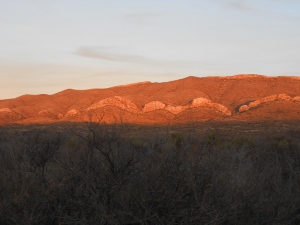Demonstrating to ourselves that we can cross the country repeatedly and continue to find new beautiful and interesting places, we visited Big Bend  Sunrise near Big Bend
National Park. This is the most remote of our National Parks and one of the loveliest. Its name derives from the large curve in the Rio Grande River which forms the national border between the United States and Mexico south of El Paso.
Sunrise near Big Bend
National Park. This is the most remote of our National Parks and one of the loveliest. Its name derives from the large curve in the Rio Grande River which forms the national border between the United States and Mexico south of El Paso.
In early December the weather is just about ideal. In fact, one of the Park volunteers says this is why he comes every year: bright sunshine and 70-degree days, and that is what we found, too.
The variety of scenery here is breathtaking. We started our morning, a couple of hours northeast of the Park, as the sky
The Chisos Mountainswas beginning to lighten but before the sun was up. We could see the mountains change from gray to orange to purple as the clouds parted. Hawks sat on phone poles, rabbits sped across the road in front of us, and at three different times we startled a buck standing in the  road.
road.
A large part of our trip took us along the Ross McDonald Scenic Drive. He was a geologist and the Park superintendent, and made sure that travelers would see a variety of views. Lots of variation in altitude assured us of many different plants, including cacti both familiar and new to us.
The Chisos Mountain range is completely within the park boundaries. This is a large area -- like China Lake, it is "bigger than the State of Rhode Island" (and of course a mere corner of the State of Texas). The Chisos are ancient volcanic in origin; erosion has yielded a wonderfully jagged skyline.
Traces of former times include some fossils from when the Park was underwater, and more recently the ranch of the last man to sell his property when the park was organized. There are a couple of Visitor Centers, which  The Rio Grandehave useful information and exhibits. Most of the time we had the road to ourselves, as it rose and curved and dipped.
The Rio Grandehave useful information and exhibits. Most of the time we had the road to ourselves, as it rose and curved and dipped.
At the southernmost point, we found the river itself. Here the Rio Grande is not at all grand; it looks shallow and wadable, and on the other side is Mexico, whose steep canyon walls would prevent people from reaching the water. The Santa Elena canyon walls are so close together you'd think you could hardly move between them, and perfectly straight many feet high.
Finally we turned north west and took the dirt road to the western reaches of the park and the single highway leading West from the park. It had been a beautiful day, and we're hoping to return sometime.
 Sunrise near Big Bend
National Park. This is the most remote of our National Parks and one of the loveliest. Its name derives from the large curve in the Rio Grande River which forms the national border between the United States and Mexico south of El Paso.
Sunrise near Big Bend
National Park. This is the most remote of our National Parks and one of the loveliest. Its name derives from the large curve in the Rio Grande River which forms the national border between the United States and Mexico south of El Paso.
 road.
road.
 The Rio Grande
The Rio Grande